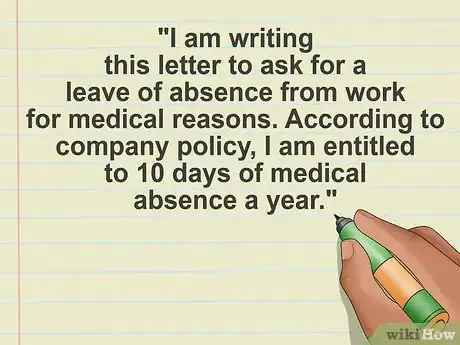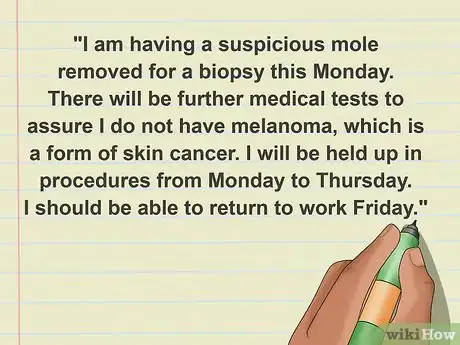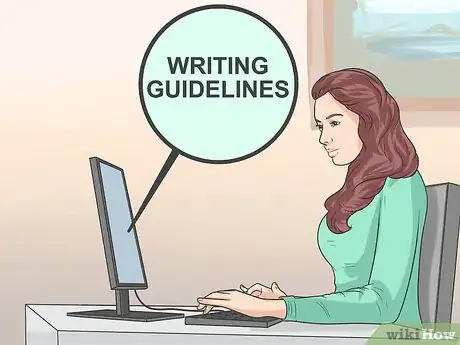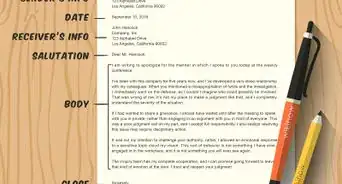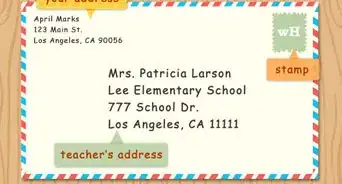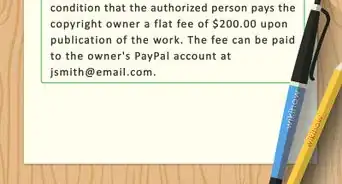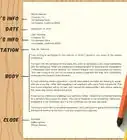This article was co-authored by Michael R. Lewis. Michael R. Lewis is a retired corporate executive, entrepreneur, and investment advisor in Texas. He has over 40 years of experience in business and finance, including as a Vice President for Blue Cross Blue Shield of Texas. He has a BBA in Industrial Management from the University of Texas at Austin.
This article has been viewed 115,299 times.
A medical leave of absence letter is a written document that informs your employer that you will need to take some time off due to medical reasons. Like any letter to an employer, you want to make sure the letter is professional and concise while clearly stating the reason for the medical leave. To write a medical leave letter, make sure you research company policy going in. From there, write a brief and concise letter stating your reasons for needing medical leave. Make sure to proofread the letter and submit it according to company policy.
Steps
Gathering the Necessary Information
-
1Learn your company's medical leave policy. Before you write your letter, make sure you know your company's policy. When asking for leave, you'll want to make sure you're asking for an appropriate amount of days.[1]
- You can look in your company's handbook, or online, to find their sick leave policy. You can also talk to the HR Department if anything is still unclear.
- You'll want to mention your company's policy in your letter. This both shows that you're adhering to policy and reminds your boss of what you are entitled to as an employee.
- If you have questions about your company's medical leave policies, you can always contact your HR department and ask about their specific guidelines.
-
2Get a note from your doctor, if required. A doctor's note may be required if you're requesting sick leave. This is not always a requirement, and it depends on the policy of your company. If you do need a doctor's note, ask your doctor to provide you one. Do so at least a few weeks in advance (if possible) so you can get all your materials together before you need to take sick leave.Advertisement
-
3Verify the dates you'll be absent. A medical leave letter needs to be specific. Before submitting your medical leave letter, you should make sure you know the exact dates during which you'll be gone.[2]
- Double check the date of your procedure. Have your doctor verify how long the recovery will be, and how much time you'll need off work.
- Make sure your sick leave falls within the appropriate restrictions of your company's policy.
Writing the Letter
-
1Format the letter properly. Business letters follow a specific format. A medical leave letter is not different. Before writing your letter, make sure it is formatted correctly.[3]
- Write down your company's address at the top of the letter. Below this, write the date in the format month, date, and year. For example, "June 5th, 2016."
- When you begin the letter, start with a salutation that begins with "Dear." Then, write your boss's name using his or her preferred personal title (e.g., Mr., Mrs., etc.).
-
2Begin by stating the reasons for your leave and its duration. Your introductory paragraph need not be long. You simply need to write the reason for writing the letter, why you need a leave of absence, and the dates you'll be absent from work. As your boss is likely busy, keep this letter brief and to the point.[4]
- You can begin with something like, "I am writing this letter to ask for a leave of absence from work for medical reasons. According to company policy, I am entitled to 10 days of medical absence a year."
- From there, state the medical concerns and the dates when you'll be absent. For example, "I am having my gallbladder removed. My surgery is on Thursday the 16th, and I will require 7 days of recovery. I should be back to work by the following Thursday, the 23rd."
-
3Explain your medical condition, if necessary. If you have an unusual medical condition, it may be necessary to explain. Something like maternity leave is largely self-explanatory, but more unusual reasons for medical leave may require some explanation. This can help your boss see why your leave is necessary. You do not need to provide a lot of details, but a little information can help.[5]
- For example, you can write something like, "I am having a suspicious mole removed for a biopsy this Monday. There will be further medical tests to assure I do not have melanoma, which is a form of skin cancer. I will be held up in procedures from Monday to Thursday. I should be able to return to work Friday."
- Be brief when writing your letter; there's no need for embellishment. Just stick to the facts to keep it professional.
- If you live in the United States, there are specific laws to protect your privacy, known as HIPAA. Your employer should not request more information than is necessary, and they have obligations to maintain your privacy under certain conditions.
-
4Let your boss know how you plan to handle work responsibilities when on leave. Your boss needs to know you plan on keeping up with your responsibilities during your absence. Your boss will want to know the status of your work, and how it will be completed while you're gone.[6]
- If you're assigning your work to other colleagues, mention this. Make sure you ask the colleagues beforehand and get confirmation that they can take on your projects. Write something like, "The Henderson account will be managed by Charlie Hanson until my return."
- If you plan on working remotely, let your boss know. For example, "While I will be laid up after my knee surgery, I'll still be able to carry on much of my duties. I plan to work remotely and Skype into meetings during my absence."
-
5Close with information on how to contact you. Let your boss know how he or she can reach you if you're needed during your absence. Include the best phone number and email your boss can use to contact you.[7]
- If there's any time you know you'll be unavailable, mention this. For example, "You can reach me on my regular cell phone most of the time. However, my surgery is Thursday so I will be unable to take work-related calls then."
-
6Thank your boss before adding a closing line. Close the letter by offering your boss a sincere thank you for considering your application. For example, say something like, "Thank you so much for taking the time to consider my medical leave." Then, add a formal sign off, like "sincerely," before signing your name at the bottom of the letter.[8]
- If you're adding an enclosure to the letter, like a doctor's note, make sure to write "Enclosure" one line below your name at the bottom of the letter, followed by a description of the enclosure.
Revising and Submitting the Letter
-
1Proofread the letter carefully. It's a good idea to proofread your letter before you send it out to make sure it's free of obvious errors. If possible, have a friend or colleague quickly proofread your letter before you send it to your boss.[9]
- Set the letter aside for a few hours and then come back to it with fresh eyes. This can help you catch errors.
- You could also try to print the letter out if you typed it. You may have a better chance of catching your own errors when not reading on a screen.
-
2Make sure you follow any formal letter writing guidelines laid out by your office. Check company policy again. They may have special policies for business letters. For example, your office may require specific formatting or may ask that you use the company letterhead.
-
3Send the letter out according to company policy. Send the letter out when you're done. Make sure you follow company policy regarding how to send letters and memos. Do not, for example, e-mail the letter as an attachment if your boss prefers letters be sent physically.
References
- ↑ http://www.livecareer.co.uk/templates/letter-samples/leave-letters/
- ↑ http://www.letters.org/leave-letter/leave-letter-format.html
- ↑ https://owl.english.purdue.edu/owl/resource/653/01/
- ↑ http://www.letters.org/leave-letter/leave-letter-format.html
- ↑ http://www.livecareer.co.uk/templates/letter-samples/leave-letters/
- ↑ http://www.letters.org/leave-letter/leave-letter-format.html
- ↑ http://www.letters.org/leave-letter/leave-letter-format.html
- ↑ http://www.letters.org/leave-letter/how-to-write-a-leave-letter.html
- ↑ http://writingcenter.unc.edu/handouts/editing-and-proofreading/
About This Article
To write a medical leave letter, you'll need to explain to your boss why you need time off and how long you need. Before you write your letter, check your company’s policy in its handbook or talk to someone in human resources so you know what to include. Generally, you should tell your boss which days off you need and why. You don’t need to go into detail if you don’t want to, but at least say something like, “I’m having a minor surgical procedure on the 5th of June and I’ll need 5 working days off to recover.” If your company requires it, attach a copy of your doctor’s note as proof. You should also arrange for any specific responsibilities you have to be covered by other staff while you’re away. Let your boss know of these plans in your letter. Finish by thanking them for considering your leave and provide your contact details so they can reach you while you’re away. For more tips from our Legal co-author, including how to layout your medical leave letter, read on.




